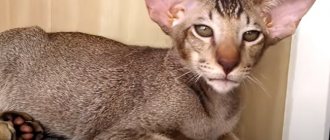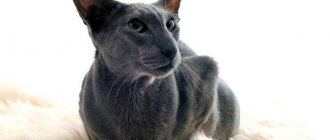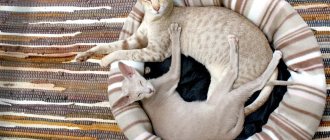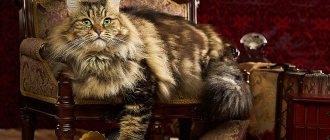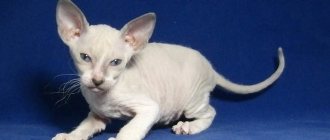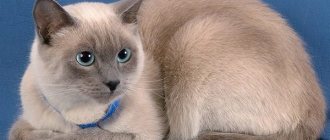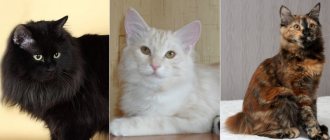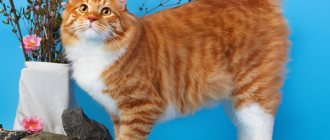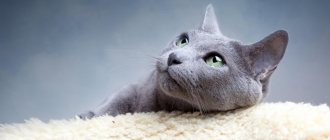What is a standard? This is a description of the ideal animal of this breed, which one should strive for!
The ideal Oriental cat is a slender cat with a long tapering body, very flexible yet muscular. Excellent physical condition. The eyes are clear. Strong and slender, neither bony nor doughy. Not fat. The longhaired variety of the Oriental breed has a softer coat and a less extreme body type than the shorthaired variety.
Head: shaped like a long, tapering wedge, well proportioned to the body. The general wedge starts from the nose and continues in a straight line to the tips of the ears, forming a triangle without kinks on the whisker pads. The eyes are located at a distance of at least the width of the eye. When the mustache (and beard on longhairs) is pulled back, the underlying bone structure is visible. Cheeks of breeding cats are allowed.
Skull: flat. In profile - a long straight line from the top of the head to the tip of the nose, without protrusion of the eyes or deflection of the nose.
Nose: long and straight. Continues the forehead without a break.
Muzzle: thin, wedge-shaped.
Chin and jaws: medium size. The tip of the chin is in line with the tip of the nose in a vertical plane. Neither weak nor too massive.
Ears: Strikingly large, pointed, wide at the base, continuing the lines of the wedge of the head.
Eyes: almond-shaped, medium size. Neither convex nor recessed. Harmoniously inclined towards the nose along the wedge lines of the head and ears. No squint.
Body: long and flexible. A peculiar combination of thin bones and strong muscles. The shoulders and hips continue the lines of the elongated body. Hips no wider than shoulders. The stomach is tight. Males can be somewhat larger than cats.
Neck: Long and flexible.
Paws: long and thin. The hind legs are higher than the front legs. In good proportion to the body.
Feet: Graceful, small and oval. Toes: five on the front paws, four on the hind paws.
Tail: Long, thin at the base, tapering to the tip. In the long-haired version of the breed, the hair on the tail forms a kind of train (plume).
The coat of the Oriental Shorthair is short, fine in texture, shiny or satin-like, lying close to the body. The Oriental Longhair has medium length, fine, silky, without fluffy undercoat, lying close to the body; it may appear shorter than it actually is. The hair on the tail is longer.
History of the Oriental cat breed
Oriental cat
Genetically, oriental cats are close to the Siamese, with whom they began to be exported from Thailand in the 19th century. British breeders did not consider (or did not want to consider) green-eyed cats as an independent breed, so they classified them as a classic Siamese with a modified type of color. It is worth noting that at European exhibitions Orientals were not particularly favored, systematically disqualifying mustachioed emigrants either for non-standard colors or for the emerald shade of the iris.
The animals also did not arouse much interest among potential owners, so until the beginning of the 20th century, Oriental cats were bred only by enthusiasts who were passionate about breeding activities. The real crisis fell on the Thai Eared Cat in 1923, after the American Siamese Cat Club strictly tabooed the breeding of any variety of pets, with the exception of blue-eyed individuals with the Himalayan color.
For almost 30-odd years, Orientals were in limbo: they were expelled from the Siamese clan, but were never recognized as an independent breed. They remembered the cat only in the 60s by British and American breeders, who were carried away by the extreme appearance of animals. Initially, breeders planned to develop another variety of Siamese cat, which would have a uniform coat color, but would not lose the grace of its lines. To achieve this goal, Orientals began to be crossed with Abyssinians and other short-haired breeds.
1977 was a landmark year for Orientals, in which the wards of American breeders received their own standard of appearance. By the way, the first set of breed characteristics developed for overseas murkis was almost completely copied from the Siamese standard (with the exception of the points “body” and “colors”). But in Britain they were in no hurry to honor Asian cat breeds and spent 20 long years looking closely at them, scrupulously weighing the pros and cons. As a result, English long-eared cats were able to become an independent breed only in 1997, after official recognition by the GCCF.
Oriental cat with cat
Black oriental cat
Origin story
The birthplace of Orientals is Thailand. First learned in the 13th century AD. e. They were mentioned in the ancient scripture about cats. For several centuries, the authorities imposed a ban on the export of these exotic cats outside the country. Therefore, in other states no one knew or even heard about them.
Oriental cats first appeared at a London show in 1894. But the contestants were disqualified. The judges decided that these were Siamese representatives with chestnut fur and green eyes. And this does not meet the standard. The same thing happened 2.5 years later at an exhibition in England.
Oriental
Active breeding of this breed began in the 50s. 20th century two ladies: Baroness Edith von Ullmann and Armithog Horgraves. Orientals owe their existence as individual representatives. The first kittens we got were chocolate colored. Then we managed to develop blue, beige and other colors.
Exotic appearance
Siamese were crossed with other breeds of suitable color - Russian Blue, Abyssinian. Outbred individuals with black fur were also involved in the process. Thanks to the emergence of a variety of colors, interest in Orientals increased and in 1977 they received official status as a separate breed.
Appearance of an oriental cat
Orientals are typical Asians: graceful, lean, with the hypnotic power of a jade gaze. A distinctive feature of these charismatic pussies is their phenomenal plasticity of movements, thanks to which even ordinary stretching in their performance turns into a full-fledged yoga master class. Based on their coat type, Oriental cats are divided into short-haired and long-haired. The latter variety was born in the 60s of the last century as a result of crossing a shorthaired Oriental with a Balinese (Balinese cat). The Oriental Longhair was introduced as an independent breed in 1977, but it was only able to confirm its worth at exhibition competitions in 1997.
Head
Oriental kitten
According to the standard approved by the WCF (World Cat Federation), the head of an Oriental must have a flat forehead and a prominent profile. The muzzle of representatives of this breed should be narrow, and the chin line should be clearly defined. A mandatory item is the wedge-shaped shape of the skull.
Nose
Elongated, smooth. Located approximately in line with the chin.
Eyes
Almond-shaped, slightly slanting. The distance between the eyes is visually equal to the length of one of them. Regardless of coat color, all Orientals have rich emerald eyes. An exception to the general rule are white-haired individuals, whose iris color may be blue. Some cats have heterochromia (different eyes).
Ears
Quite massive in relation to the head. The ear flap is thin and wide, continuing the wedge-shaped line of the cat's muzzle. The tip is slightly rounded. The most intensive growth of the ears is observed in the first months of the animal’s life, which is why the Oriental kitten resembles a hybrid of Cheburashka and Yoda from Star Wars.
Neck
Graceful, elongated type.
Oriental cat face
Torso
Slender, noticeably elongated in length, with a well-developed muscle corset. The constitution of the body is close to lean: the animals look elegant and graceful.
Limbs
Oriental longhair cat
Oriental cats have extremely long limbs, giving their silhouette a slight aristocracy and grace. The animals' paws are oval and relatively small.
Tail
Whip-shaped, very long, with a sharp tip. The thickness of the tail is the same along its entire length.
Wool
Oriental cats have virtually no undercoat, allowing the fur to softly outline the contours of the body. The hair of short-haired individuals is shiny, satin-type. Long-haired animals have thin, silky hair. Since representatives of the second type have hair that fits tightly to the body, its real length is partially “lost.”
Color
Curled up into a ball
What the breeding experts were most loyal to were the color options for Orientals. Today, this is one of the few cat breeds that has the right to almost any shade of all existing ones.
In order to systematize the “colors” of eared cats, their basic types were identified by felinological associations. In particular, modern Oriental cats can have coats of such colors as:
- lilac (lavender);
- blue;
- red;
- Havana (brown);
- cinnamon (cinnamon);
- faun (beige);
- ebony (black);
- cream;
- white.
The preferred tabby colors are merle, brindle, ticked and spotted.
Defects and disqualifying defects of the breed
Serious defects that spoil the aristocratic appearance of Oriental cats include strabismus, any shade of the iris except green, as well as protruding and clearly palpable cartilage in the sternum area. As for exhibition events, first of all polydacts, very small or too thin individuals and cats with kinked tails will not be allowed to attend. The list of defective pets includes animals with insufficiently strong hind legs, spots on the fur in the form of medallions, as well as cats that breathe through their mouth. In the long-haired variety of Orientals, a double coat with a well-developed undercoat may be a reason for disqualification.
Pattern genes: agouti and tabby
The agouti gene A controls the possibility of the appearance of a pattern on six, i.e. stripes, spots of various shapes, as well as ticking - Abyssinian color. Allele A is dominant - there is a pattern, allele A is recessive - there is no pattern, the cat has a solid coat color. The natural color of a wild cat is a patterned coat, while the smooth, solid colors are artificially bred.
| black spotted | black smooth |
Inheritance of the agouti A gene (there is a pattern, there is no pattern) occurs according to the usual “dominant-recessive” pattern, similar to the inheritance of Siamese-non-Siamese color.
Table of possible combinations of parental genotypes for genes A and a
Often in cats of solid colors you can notice a barely noticeable tabby pattern. This is acceptable for kittens and adolescents; with age, the residual pattern should disappear. The reason for the appearance of a light pattern is that every animal carries some kind of pattern gene - spotting, marbling or ticking. But in the presence of gene a (“non-agouti”) the pattern is suppressed; it is not visible, but is present in the genotype of the animal. If you breed a smooth-colored animal with a tabby partner, the pattern will appear.
The Tabby T gene determines what specific pattern a cat's coat will have—striped, spotted, marbled, or ticked. All types of patterns have stripes on the face, paws and tail. There is a characteristic pattern in the form of the letter “M” on the forehead; clear stripes of solid color run from the outer eyes of both eyes to the cheeks.
The T gene has the following variants:
- Abyssinian (ticked) tabby Ta: the body is without stripes and spots, each hair is ticked - dark and light areas on it alternate, so that the coat looks like freckles, speckled.
- Brindle Tabby T - narrow vertical stripes on the sides, clear and numerous. The spotted tabby is genetically the same as the brindle, but the stripes are broken into separate spots. There is no specific gene for spotting, or it is unknown. In cats of the Oriental breed, the spotted color is much more common than the brindle color.
- Marbled, or classic tabby tb: the cat has beautiful stripes on the sides in the form of horizontal loops (“bull’s eyes”) and a “butterfly” on the back. The pattern resembles marble stains.
black ticked | black spot |
black marble | The Abyssinian tabby Ta is dominant over the brindle (spotted) tabby T, the brindle (spotted) tabby is dominant over the marbled tabby tb. Those. It is quite easy to get a ticked or spotted animal, but getting a marbled pattern is possible only from two animals - carriers of the tb allele. Inheritance of the T gene, which determines the type of pattern, occurs according to the usual “dominant-recessive” pattern, similar to the inheritance of Siamese-non-Siamese color. |
Table of possible combinations of parental genotypes for the T(spot) and tb(marble) genes
Inheritance will be the same for other pairs of alleles of the T gene: Ta and T, Ta and tb - according to the “dominant-recessive” scheme.
Genes can influence each other. For example, the O - “red” gene is not affected by the a allele (“non-agouti”, lack of pattern on the coat). Therefore, all cats of red (and cream) colors always have a tabby pattern on their coat (stripes, spots or ticking), regardless of which version of the agouti gene the cat has - A or a.
Those. if a cat has the genotype AA OO TT, then it is genetically an “agouti”, a cat with a pattern. And a cat with the aa OO TT genotype is genetically “non-agouti”, a cat without a pattern, but outwardly both cats look the same.
Some breeders produce red and cream cats that appear solid in color - this is why they choose to breed animals with patterns of reduced contrast. However, the letter “M” on the forehead of such cats is still present.
Photos of oriental cats
Character of an oriental cat
If, when buying a baby Oriental cat, you expect to receive an arrogant sofa Buddha in the future, do not hope - the Asian mentality in these cats is sleeping soundly. Purebred Orientals are quite sociable and playful pets, madly in love with their owner. Eastern arrogance and detachment are absolutely not characteristic of them.
Oriental cat during play
Oriental cats are characterized by dog-like behavior. This means that wherever the owner goes, the “wool Yodas” will definitely attach themselves to the side to control his every step. Consider the fact that you will only dream of peace with these perpetual motion machines, jumpers and runners. Sofas for oriental cats are not a habitat, but a convenient springboard from which it is so convenient to “fly up” onto a closet, chest of drawers or cornice. Conquering heights, to which cats so selflessly devote themselves, brings with it inevitable destruction in the interior, therefore, if a vase broken by a pet can seriously spoil your mood, it is better not to get an oriental cat.
Oriental cats are inveterate gambling addicts, and this addiction cannot be treated, so buy your pet more wind-up mice, teasers and balls - let him have fun for his own pleasure. With age, Orientals do not lose interest in games, so even older individuals enjoy chasing candy wrappers and paper balls around the floor. Another characteristic feature of the breed is its burning curiosity. Oriental cats simply cannot stand secrets, no matter how insignificant they may be. The contents of any closed container are subject to thorough inspection, and slammed doors to another room are completely regarded as a military secret that must be revealed at all costs.
Skoda
Oriental cats are very dependent on human attention. They can hardly tolerate loneliness, so before buying a Thai long-eared dog, you should think carefully about who will stay with the pet while you are at work. As for the annoying meowing, which many owners of Orientals complain about, it really does occur, so the “talkativeness” of the breed will have to be taken for granted. But the timbre of the voice of these kitties is more pleasant than that of the same Siamese.
Most Oriental cats have a bright personality. For example, some individuals are not very friendly towards children, while others, on the contrary, treat the younger generation with great condescension. Orientals get along well with other cats. But they may experience a slight mistrust of dogs, which passes over time. According to experts, the green-eyed “Asian” should not be the only pet in the house, because the presence of other animals in the room helps him endure separation from his owner less painfully.
Oriental in the hands of the owner
Negotiation
Training and education
Walking an oriental cat on a leash
Orientals inherited from their Thai ancestors a lively, sharp mind and excellent learning abilities. In particular, it is easy to “train” a cat to fetch objects, as well as to carry out simple commands. As for the basics of etiquette, their pet will have to be instilled, because, despite the fairly high level of intelligence, oriental cats are capable of minor dirty tricks. For example, little eared cats love to swing on curtains and dig into flower pots. They do this not out of harm, but out of thoughtlessness, so it is very important to immediately point out to the kitten that such behavior is unacceptable.
Punishing, let alone beating, an animal is the last thing. An Oriental cat can easily guess about its own mistakes, relying only on the intonation of your voice, so use this quality to its full potential. Sternly shout at the mustachioed lawless man walking around the table and hiss expressively at the kitten climbing the curtains. You can be sure that the pet will intuitively understand what they want from him.
A common mistake that can negate the results of all your efforts is periodic exceptions to the established rules. As an example: today a serious reprimand has been given to the kitten jumping on the table, and tomorrow you are filming a video for YouTube where the tiny Cheburashka is briskly climbing the tablecloth to your encouraging comments.
Maintenance and care
Oriental cats do not require any special or labor-intensive care. Thai long-eared cats prefer to take care of the cleanliness of their fur themselves, which, by the way, they do quite well. The owner just has to buy a rubber mitten to clean off loose hairs from the pet’s body during seasonal shedding. The same procedure can be carried out using an ordinary damp cloth: shedding wool easily sticks to damp matter. It is generally not recommended to bathe Orientals. An exception can only be made for an animal that is too dirty or for individuals preparing for an exhibition.
Sleepy kingdom
Cats have their ears cleaned no more than once a week. No special equipment is required for this procedure, except for a cotton swab and disinfectant lotion, which can equally well replace regular Vaseline. Regularly examine your pet's eyes, removing accumulated dirt and mucus with a cotton pad soaked in boiled water. Ideally, Oriental cats should also have their teeth brushed, but in practice, few owners want to participate in this painstaking process. If for some reason you are unable to treat your pet’s oral cavity, try to minimize the risk of plaque and tartar by purchasing dry food. Densely pressed “drying” croquettes do a good job of cleaning teeth and are quite capable of replacing a regular brush. For animals that eat wet canned food, you can buy special veterinary treats for dental plaque (sausages and bones for dogs are suitable).
Caring for an Oriental cat's claws begins with the purchase of a scratching post. But since the nail plate of representatives of this breed grows quite intensively, once a month they should have a “pedicure” session. Shorten the claw by no more than 2 mm, otherwise there is a risk of injuring your pet’s skin. If the cat actively resists during the process, it is better to involve an assistant in the matter and stretch out the “pleasure” for several days.
Orientals have one not very pleasant trait - they love to taste indoor flowers. If a green-eyed kitten of this breed appears in your home, it is better to remove Dieffenbachias, azaleas and other plants that are poisonous to cats from his field of vision. The same applies to open windows. For the gutta-percha “Asian”, falling out of them is a matter of a few seconds.
Feeding
You won’t be able to save money on buying industrial food with oriental: the digestive system of the lop-eared “Thais” is simply not able to properly digest the food from your table. So, in the case of food, the owner of an Oriental cat has only two options: treat the pet with wet canned food or transfer it to “drying”. By the way, cats themselves prefer the first option, while their owners are more focused on dry food, which is cheaper and lasts longer. If you want to please your pet, but not at the expense of your own comfort, try alternating between canned food and dry food. The only thing you shouldn’t do is mix both types of food in one feeding.
Within Temptation
Sometimes an eared cat can be pampered with natural products, for example, a piece of lean meat, fish fillet, or oatmeal with milk. But you shouldn’t organize such belly celebrations too often. Firstly, the pet will quickly get used to the treats, which can lead to a loss of interest in commercial food. Secondly, such gluttony leads to obesity, to which Orientals are already prone. The cat's daily menu should not be very varied, so that the animal is not tempted to eat in reserve. Choose a suitable type of premium food for your mustachioed friend (options for Siamese cats are suitable) and do not deviate from the set course.
Oriental merle cat
Note: you can determine how suitable a particular type of food is for a cat by the condition of its fur. A soft, glossy coat without signs of dandruff indicates that the diet has been chosen correctly.
To discourage your Oriental cat from overeating, always leave enough food in her bowl. It is undesirable to feed an animal on a schedule, since pets regard this as the threshold of a serious hunger strike and consume more food than they need.
For the normal functioning of all body systems, it is useful to mix vitamin-mineral complexes into the food of Orientals. In particular, calcium and taurine supplements are recommended for young individuals. And of course, do not forget to provide the animal with round-the-clock access to clean water.
Toilet
Orientals are very smart and clean cats. Usually 3-month-old babies from the nursery already know what a tray is and how to use it correctly. If the kitten stubbornly continues to walk past the toilet, it is important to understand that he is not doing this out of harm. The tray may be in the wrong place. For example, if the toilet is located in the bathroom, the animal may be irritated by the smell of household chemicals.
It is better if the tray is in a secluded corner where no one will see the baby and where he can truly relax. A kitten sitting down to relieve itself in the wrong place must be frightened, but this should be done in such a way that the animal does not understand that the source of the threat is the owner. For example, you can clap your hands loudly, spray the Oriental cat with water from a spray bottle, or throw some kind of soft toy at it.
Feeding
Orientals value a fit and muscular body, so they should not be overfed. But representatives of the breed are big food lovers. They will constantly demand food. If the owner refuses for some reason, then theft has not yet been abolished. They will find it, steal it, eat it. Therefore, you cannot follow the lead. One or two “begged” treats and the oriental will already “twist the ropes” out of the owner, and begging for a tidbit will become a habit. However, excess weight in cats not only spoils their appearance, but also causes health problems.
Natural nutrition
Orientals are not picky when it comes to food, but the diet must be balanced. This is not easy to achieve with natural feeding. However, if the owner is a supporter of natural nutrition for his pet, then when preparing and calculating the dosage, the following must be taken into account:
- A cat consumes 5 to 10% of its own weight per day in food. Kittens and young pets eat more, but with age the appetite becomes moderate. Of course, everything is individual, the main thing is that the cat gets enough to eat.
- As a percentage, daily feeding is 3https://68koshek.ru/soderzhanie/pitanie/perevesti-koshku-na-drugoj-korm0% meat (chicken, veal, chicken stomachs, hearts, necks), 25% vegetables (zucchini, pumpkin, carrots), 20% porridge (rice, buckwheat), 25% fermented milk products (cottage cheese, kefir, fermented baked milk, yogurt, yogurt).
- All new products are introduced into the diet carefully to avoid problems with the gastrointestinal tract and the development of food allergies.
Health and diseases of Oriental cats
Handsome men
Despite the fact that the average life expectancy of Orientals is 15-17 years, they cannot be called real big guys. By inheritance from Siamese ancestors, cats have inherited a whole set of genetic ailments that significantly complicate their lives. Many individuals are diagnosed with liver amyloidosis, which, if not treated promptly, can cause liver failure. Another scourge of the breed is myocardial disease (dilated cardiomyopathy), so the animal must undergo ultrasound diagnostics at least once every six months.
Eye problems among Oriental cats are also quite common. Most often, “Thais” suffer from strabismus and progressive retinal atrophy. In addition, there is always a risk of kittens being born with flat chest syndrome. If the disease is not recognized and treated in time, the baby’s lungs will not be able to work at full capacity, and he will simply suffocate.
Description of the breed
Known for its elongated head, tall ears and slender legs, the Oriental Shorthair may seem extreme compared to other cat breeds. The Oriental cat's facial features may not be to everyone's taste, but her temperament makes up for her odd body proportions.
Orientals in the extreme type are a representative of the breed with pronounced breed traits. Low-set ears, an elongated muzzle, a straight profile, very short and close-lying hair and a thin body constitution are the decisive factors that will affect the final price of an Oriental cat.
The appearance of such extreme Orientals is very bright and not everyone likes it, but they are good for breeding and developing the breed, as they help to consolidate one or another external trait in kittens.
These cats command all the attention they can get and are particularly intelligent and receptive to learning. In addition, they require minimal care and are very fond of children.
INTERESTING! Typically, the most common reason for not adopting a cat as a pet is an allergy caused by the allergen agent Fel-d1. Oriental Shorthair cats can be virtually hypoallergenic because they produce lower amounts of the Fel-d1 allergen than most breeds.
Oriental cat standard
Description of appearance:
- Body: this is one of the main characteristic features of Orientals and the entire eastern group - an elongated body, limbs, and a long tail. The body is thin-boned, graceful, athletic, fit. The tail is long, thin, like a whip. The chest part of the body protrudes, sometimes you can see the sternum in the shape of a keel. Male weight up to 6 kg, female up to 4.5 kg.
- Head: absolutely triangular. The shape of the ori head is in the form of an equilateral triangle with corners at the extreme points of the ears and chin. It is flattened, there is no transition between the tip of the nose and the forehead, the profile is straight.
- Eyes: The eyes are large, the color of the eyes depends on the color of the animal, mainly green and blue. The eyes are elongated, located obliquely, parallel to the sides of the triangular muzzle. Inconsistency between eye color and coat color is a disqualifying sign, along with strabismus.
- Nose: The nose is fairly wide, the profile is straight and long. In kittens, the bridge of the nose may be sunken, but it straightens out with age.
- Ears: Large, triangular, wide at the base and set far apart. The ears are arranged in such a way that the overall head has the shape of an equilateral triangle, and the pointed tips of the ears are its corners.
- Limbs: long, fine-boned, with small oval paws. The gait is graceful.
- Coat: short, silky, without undercoat, lying close to the body.
- Acceptable colors: more than 300 combinations - Orientals are rightfully the most colorful cats among all breeds.
Main colors:
- ebony (black solid), paws and nose are black, eyes are green;
- red , bronze (no pattern), paw pads and nose – pink;
- lavender (lilac, without blue shades), paws and nose are pink-lavender, eyes are bright green;
- Havana (brown, chocolate) – paws are brown-pink, nose is brown, eyes are bright green;
- blue (gray with blue, with an admixture of silver) - the pads of the paws and nose are blue, and the eyes are green;
- cream (fawn), fawn (beige), cinnamon (red, light brown), pink paws and nose;
- tricolor (tortoiseshell), a combination of white, black and red colors; the pads and nose are pink, black spots are possible;
- white (without yellowness), paws and nose are soft pink, eyes are blue (foreign white), green, or one is blue and the other is green.
These are the main solid colors, and Ori can also have a tabby color (spots, brindle stripes, marbled, ticked, etc.) superimposed on any of the main colors and smoky (this is when a hair of the coat is not completely dyed, it is white at the tip).
Health
Although Asians are a generally healthy breed, they do have a tendency to develop several health-related problems. Progressive retinal atrophy and lymphoma are common diseases in this cat breed. Other characteristic diseases: amyloidosis and congenital heart problems such as megaesophagus or hypertrophic cardiomyopathy.
Typically, the main diseases begin to develop at the age of 6 years and older. The health status is influenced by environmental factors, nutrition and activity of the animal.
It is advisable to have enough space for the pet to move and to feed it in a balanced manner. Many breeders prefer mixed nutrition. Oriental cats have special dietary requirements. They need a high quality cat food that contains the vitamins and taurine found in meat products.
Health problems can also arise from improper care of your pet. If you brush your Oriental's hair too hard and with the wrong brush, your cat may develop skin inflammation. This is due to the fact that Orientals lack a protective undercoat and the skin is easily damaged.
Character of Orientals
The character of the Ori can be described in two words - “center of attention.” Asians always want to be the center of attention. They don't care if you have a job, watch TV or read a book. They will jump on your lap and demand your attention.
They are also very talkative. A million shades, not a single repeating sound - this is how the owners describe the communication of the Oriental. Whether it's a contented purr, a hiss, or a meow, their voices will be heard all the time. If you ignore your Oriental kitty for too long, it can drive you crazy with its loud cries for attention.
The voice of Oriental cats becomes louder and more demanding at certain moments, for example, they want to eat, they want to relieve themselves, or they are in sexual heat, the rest of the time the volume of their voice is average.
Important! Often people do not realize the degree of talkativeness of Asians, sometimes this is the reason for owners' refusals and the cats being re-adopted to another family.
The talkativeness and loudness of Orientals can be regulated by education, the main thing is to do this during the kitten’s formation period, namely from 3 to 6 months. The owner's behavior must be firm and consistent. You shouldn’t allow yourself to shout at Easterners - they are very touchy. Easily respond to raising the tone of voice. You need to communicate softly, firmly, and encourage with positive reinforcement.
Important! Orientals need attention; if you are at work all day, be prepared for a violent manifestation of emotions in the evenings, and sometimes this can last all night. If you are forced to leave your pet alone all day, then it is worth getting a companion for him. It could also be an Oriental or another breed. Check with your breeder.
Ories are very smart animals, they are considered one of the smartest cat breeds. Therefore, they are quite trainable, and not only the rules of behavior, but also various tricks. You can teach your Oriental kitty a number of tricks, including how to respond to her name, sit, jump through hoops, and even give high fives (high fives). Because these cats enjoy all the attention they can get, they can become outstanding trick performers.
If you are patient and dedicated, and use positive reinforcement techniques, you can teach your Oric a huge variety of impressive tricks.
Children and family, other animals
Not all cats are suitable for large families, and especially not for small children. However, this does not apply to Oriental Shorthair cats. Their playfulness, intelligence and willingness to do anything for attention make them ideal companions for large families.
One of the disadvantages of owning an Oriental Shorthair is that it will become jealous of your attention if you bring home another pet. Of course, there is always a chance that an Oriental kitten will become friends with a new pet, but his constant need to be the center of attention can complicate the situation. Therefore, it is worth introducing a new animal into your home after consulting with an Oriental breeder.
The long legs and slender bodies of Oriental cats look elegant and athletic, they are enviable athletes and love to climb, jump and play all day long. Buying interactive cat toys and a cat tree house will make your Oriental the happiest kitty on the planet. Their playfulness does not go away as adults.
A quiet and strict home environment is not suitable for these cats. They need regular play and lots of social interaction.
How to choose a kitten
When buying an Oriental breed kitten, be sure to ask about its age. Nurseries that value their own reputation do not sell animals that are under 3 months old. When assessing the conditions in which babies are kept, pay attention to whether the breeder has cages in which unscrupulous sellers often lock their charges. Experienced specialists who love their work raise kittens in a home environment: they play with them, they are not put in an enclosure and are not limited in communication with other pets. Accordingly, such individuals will undergo socialization faster.
Oriental kittens with mother
Its appearance will also help to assess the health of an Oriental kitten. Eared cats with matted fur, discharge from the eyes and nose, and bloated bellies will bring nothing but problems. Any kitten purchased from a cattery must have a metric or pedigree. If there are none, then, most likely, under the guise of a purebred Oriental, they are trying to give you a mestizo. Sometimes breeders explain the lack of documents for a kitten as an unplanned mating, although this is nothing more than excuses and attempts to hide the truth about the true origin of the animal.
Those who plan to breed their pet in the future and get offspring from it should look into nurseries that sell breed-class oriental cats with impressive pedigrees. If you do not intend to breed kittens for sale, visit places where they breed orientals without breeding rights. Most of these nurseries offer already castrated or sterilized kittens.
Some breeders have a negative attitude towards early sterilization, which can seriously affect the external parameters of the cat, and do not carry out this procedure. In this case, all responsibility for the reproductive function of the pet falls on the future owner. Usually, before the sale, the buyer signs an agreement according to which he undertakes to spay/neuter the kitten as soon as it is 8-12 months old.
Pros and cons of the breed
According to reviews from owners, the Oriental breed has many advantages, but there are also disadvantages, if you can call them that.
Good companion
Gets along well with children and other animals
Loving, affectionate, gentle
Easy to learn and trainable
Very talkative, she will definitely insert her meow on every occasion
Can be annoying, as it follows the owner's heels
Unable to remain alone for long periods of time
